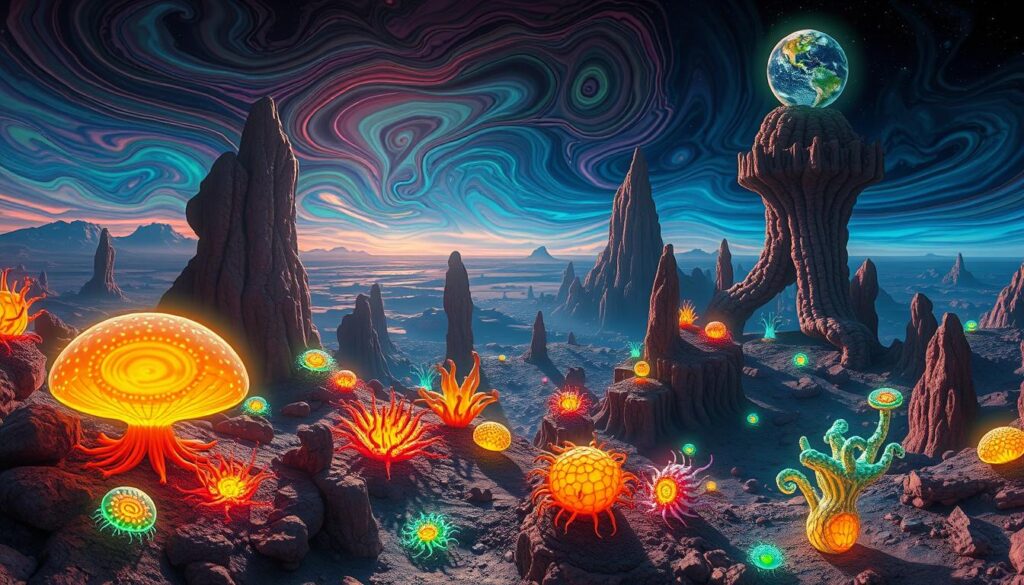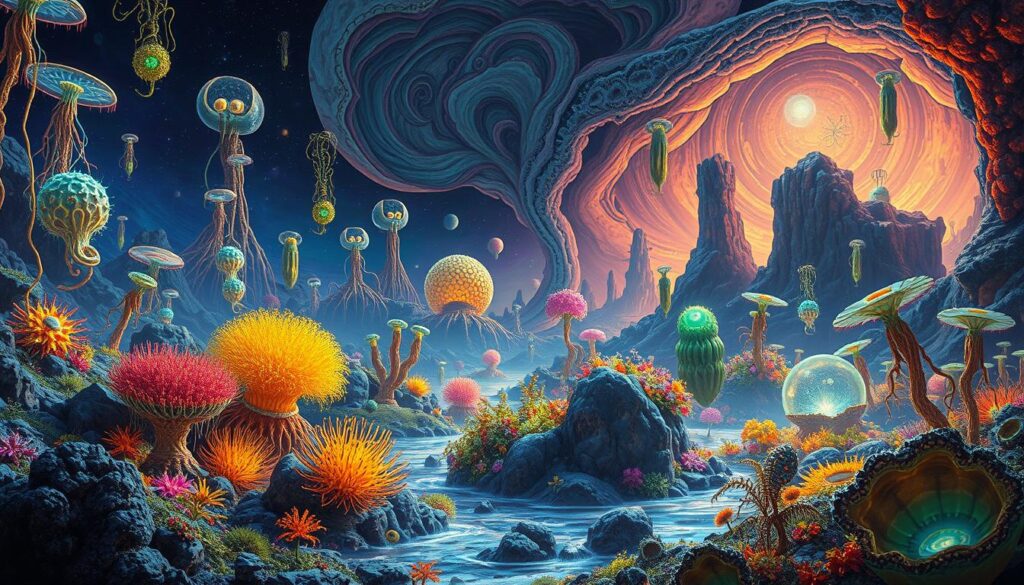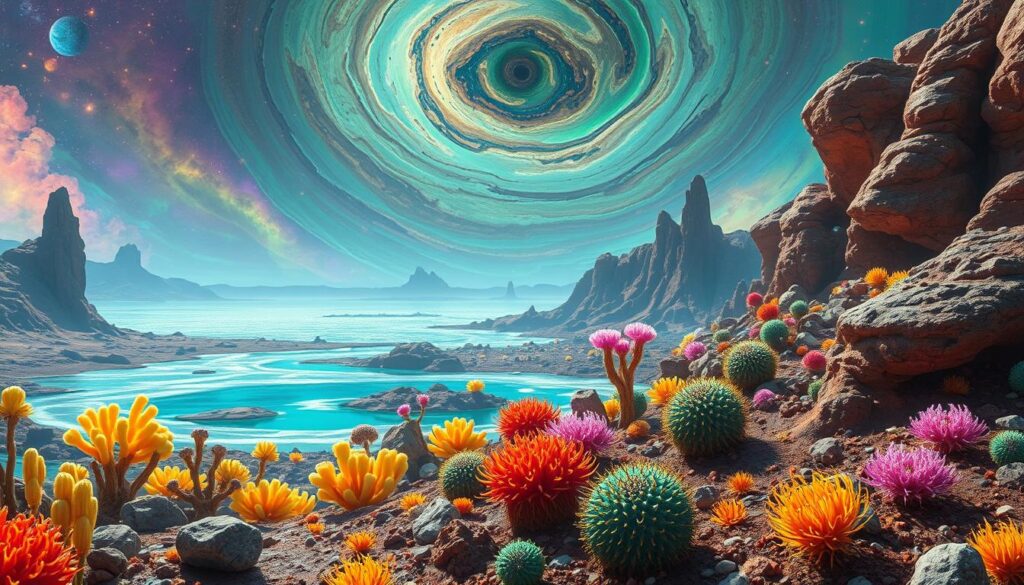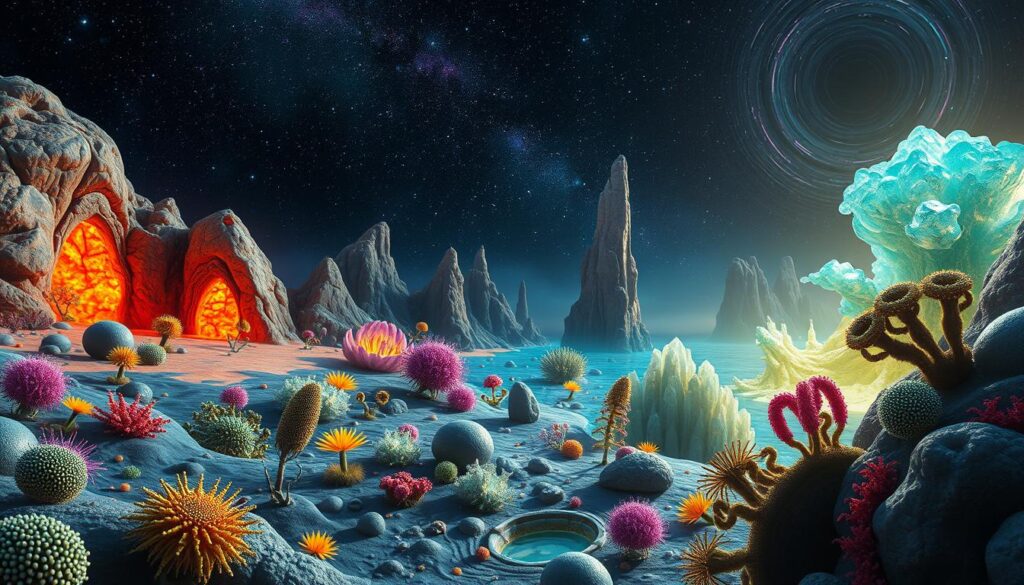Extremophiles are organisms that live in Earth’s toughest places. They help us guess what alien life might look like. Scientists found two new bacteria in Chile’s high-altitude lakes. These lakes are similar to early Mars.
This discovery is big for finding life outside Earth. It shows us how life could exist in extreme conditions.
Researchers found 66 microbes in Andean lakes, over 2.3 miles high. Gene sequencing found 63 of them. But a new method, proteotyping, found two more bacteria that gene sequencing missed.
Extremophiles can live in extreme conditions. They teach us about life’s limits and where it might exist elsewhere. By studying them, scientists can guess what alien life might look like.
Introduction to Astrobiology
Astrobiology is a field that studies life on Earth and beyond. It asks the big question: Does life exist elsewhere in the universe? Astrobiologists look at extreme environments on our planet. They search for signs of life beyond Earth.
Defining Astrobiology and Its Importance
Astrobiology, or exobiology, combines biology, astronomy, geology, and planetary science. It aims to understand life’s origins, evolution, and where it exists in the universe. This field could change how we see life’s limits and what it needs to exist.
The Search for Extraterrestrial Life
The search for life outside Earth is central to astrobiology. Scientists focus on planets like Mars, where water and organic molecules were found. They use rovers and orbiters to explore these worlds.
They also study Earth’s extreme environments to learn how life can survive. The search for life in our solar system and beyond is ongoing. Astrobiologists look for signs of life, like chemical or geological markers, to understand life’s origins and where it might exist.


“Astrobiology is a quest to understand the origin, evolution, distribution, and future of life in the universe.”
– NASA Astrobiology Program
Overview of Extremophiles on Earth
Extremophiles are amazing microorganisms that live in places we thought were impossible for life. These extremophiles show us how life can adapt in ways we never thought possible. They live in hot springs and icy polar regions, showing us that life can thrive in the most extreme environments on Earth.
What Are Extremophiles?
Extremophiles aren’t just bacteria and archaea. Some fungi, plants, and animals can also live in extreme conditions. They have special ways to survive in places that would kill most other living things. This includes very hot or cold temperatures, lots of radiation, high pressure, and very acidic or alkaline conditions.
Examples of Extremophiles Found on Earth
- Thermophiles: Thriving in hot springs with temperatures up to 235°F (113°C)
- Psychrophiles: Surviving in polar regions with temperatures as low as -25°C
- Acidophiles: Adapting to highly acidic environments with pH values near 0
- Alkaliphiles: Thriving in extremely alkaline conditions with pH levels up to 13
- Halophiles: Prospering in high-salt environments, such as salt flats
- Piezophiles: Living in deep-sea environments under immense pressure, up to 1,100 atmospheres
These extremophiles have incredible adaptations. They have special cells and genes that help them survive in the toughest environments on our planet.


“Extremophiles are the ultimate proof of life’s resilience, pushing the boundaries of what we thought possible.”
Different Types of Extremophiles
On Earth, we find a wide range of extremophiles. These are organisms that live in extreme conditions. They are mostly prokaryotic archaea and bacteria. They have evolved to survive in places that would kill most other life forms.
Let’s look at some key types of extremophiles and their special abilities.
Thermophiles: Life in Extreme Heat
Thermophiles live in very hot places. You can find them in hot springs, geysers, and hydrothermal vents. These places can get as hot as 122°F (50°C) or more.
These microbes have special enzymes and structures. They help the microbes work well in the heat.
Psychrophiles: Surviving Extreme Cold
Psychrophiles live in very cold places. They are found in the polar regions, glaciers, and deep ocean waters. These places are much colder than freezing.
These microbes make proteins and lipids to stop ice from forming inside them. This lets them survive and even grow in cold temperatures.
Halophiles: Thriving in Salt Environments
Halophiles need a lot of salt to live and grow. You can find them in salt flats, brine pools, and hypersaline lakes. These places have much more salt than seawater.
Halophiles have special ways to keep the right balance of salt inside their cells. This lets them live in these salty environments.
There are many other types of extremophiles, like acidophiles, alkaliphiles, and piezophiles. Each is adapted to different extreme conditions. Their diversity and adaptability help us understand the possibility of life beyond Earth.


How Extremophiles Adapt to Harsh Conditions
Extremophiles are amazing organisms that live in very harsh places on Earth. They have special ways to survive in places that would kill most other life. This makes them interesting for studying life beyond Earth.
Unique Cellular Mechanisms
Extremophiles have special ways to deal with their tough environments. Thermophiles can work at very high temperatures thanks to special enzymes and membranes. On the other hand, psychrophiles keep working in freezing cold with cold-adapted proteins and lipids.
Halophiles live in very salty places and use special ion transporters and solutes to stay hydrated. Acidophiles and alkaliphiles keep their cells at a stable pH, even in very acidic or alkaline conditions.
Genetic Adaptations for Survival
- Extremophiles have genetic traits that help them resist stress like radiation or high pressure.
- They have genes for special proteins and enzymes that help them live in their unique habitats.
- Thermophiles have special DNA polymerases that are used in biotechnology, like PCR.
- Halophiles keep high potassium levels and solutes in their cells to handle salty environments.
The amazing ways extremophiles adapt show how resilient and diverse life on Earth is. By studying these organisms, scientists learn about life’s potential on other planets with extreme conditions.


“Extremophiles encompass various types such as thermophiles, psychrophiles, acidophiles, alkaliphiles, halophiles, barophiles, xerophiles, and radiophiles.”
The Connection Between Extremophiles and Alien Life
Extremophiles are organisms that live in Earth’s most extreme environments. They help us understand if alien life could exist elsewhere. These microbes show us how life might survive in other worlds.
Potential Habitats for Alien Life Forms
Extremophiles can live in places we thought were too harsh for life. They handle high temperatures, intense radiation, and extreme conditions. This makes us think that similar life could exist on other planets and moons.
- The subsurface oceans of Europa and Enceladus, moons of Jupiter and Saturn, respectively
- The geothermally active regions of Mars, where water may still be present
- The clouds of Venus, where acidic conditions and high temperatures reign
The Role of Extremophiles in Planetary Exploration
Extremophiles are key in understanding life beyond Earth. Research shows they can survive in Martian-like environments. Some, like Salinisphaera shabanensis and Buttiauxella, might even be alien life forms.
The MEXEM project, starting in 2025, will take these microbes to the International Space Station. It will test their survival in space. This research will help us understand life’s adaptability and the possibility of alien habitats.


“The discovery of life, even simple microbial life, on another planet would be phenomenally exciting and would change our view of ourselves and our place in the universe.”
Case Studies: Earth’s Extremophiles in Space Research
Extremophiles, organisms that live in extreme conditions on Earth, fascinate space scientists. They study these microbes to see if they can survive on other planets. This research uses Earth’s extremophiles to understand alien environments.
Experiments Simulating Alien Environments
In 2022, scientists tested extremophilic microbes from Earth’s Mars-like spots. They exposed these microbes to Martian-like conditions. The microbes survived high UV radiation, low oxygen, dry air, and Martian soil.
Findings from the International Space Station
The Mars EXposed Extremophiles Mixture (MEXEM) project is set for 2025. It will send extremophilic microbes to the International Space Station. Scientists will study how these microbes adapt in space’s microgravity and radiation.
“Understanding the limits of life on Earth is crucial for assessing the potential for life elsewhere in the universe.”
Studying extremophiles is key in astrobiology. This field looks into life’s origins and spread in the universe. By learning how these microbes survive harsh conditions, scientists get clues about alien life on other planets.


Extremophiles as Models for Alien Life Forms
Extremophiles are organisms that live in Earth’s most extreme places. They give us clues about alien life. These lifeforms have unique shapes and ways of living that might help us guess how life could exist elsewhere.
Diverse Morphologies and Biological Structures
Extremophiles vary greatly in size and shape, from tiny cells to complex organisms. They have special ways of living and genes that let them survive in extreme conditions. By studying them, scientists can imagine what alien life might look like and how it could survive in harsh places.
Implications for Understanding Alien Environments
Extremophiles can live in extreme heat, cold, salt, or pressure. This means similar life could exist on other planets or moons with similar harsh conditions. By learning from extremophiles, scientists can better understand if other planets could support life and what life might look like there.
Extremophiles show us the limits of life and how it can adapt to extreme conditions. As we search for alien life forms, these Earth organisms might give us key insights into extraterrestrial environments that could support life beyond our planet.
“The diversity of extreme environments where microorganisms can thrive showcases the adaptability of life to a wide range of parameters.”
Impacts of Astrobiology on Science and Society
Astrobiology explores life’s origins, evolution, and spread across the universe. It impacts our scientific knowledge and tech advancements. By studying life’s limits on Earth and beyond, it broadens our cosmic understanding. It also sparks new solutions to global problems.
Enhancing Our Understanding of Life
Astrobiology focuses on extremophiles, life forms that survive in harsh conditions. This study reveals life’s adaptability and resilience. It challenges our views on life’s needs, offering insights for biotech, medicine, and space exploration.
Inspiring Technological Advancements
The quest for astrobiology fuels the creation of advanced technologies. The Kepler Space Telescope found over 1,500 exoplanets. The Curiosity rover’s Mars mission has greatly expanded our knowledge. These advancements benefit society, like in biofuel production and cleaning polluted areas.
As astrobiology advances, its influence on science and society will increase. It connects Earth to the cosmos, inspiring new perspectives. This could lead to major discoveries and innovations that help humanity.


“Astrobiology is not just about the search for life elsewhere, but about understanding the nature of life itself and our place in the universe.”
Future Directions in Astrobiology Research
The field of astrobiology is set for an exciting future. Researchers are exploring new frontiers in the search for extraterrestrial life. They are focusing on studying planets and moons in our solar system to find potential biosignatures.
Upcoming Missions to Explore Extraterrestrial Worlds
NASA’s Mars 2020 mission, including the Perseverance rover, is searching for signs of ancient microbial life on Mars. Future missions to Jupiter and Saturn’s moons, like Europa and Enceladus, aim to explore these potentially habitable environments. They hope to find signs of life.
The Search for Biosignatures
New techniques like proteotyping are helping identify potential life forms in space. Researchers are also using artificial intelligence to better understand exoplanets. This could lead to finding biosignatures beyond our solar system.
The Astrobiology Program is working across different research areas. This collaboration is key to advancing the field. As we continue searching, upcoming missions and the hunt for biosignatures promise to reveal the secrets of life in the universe.


“The search for biosignatures, or chemical traces of life, is a key focus of these missions.”
The Ethical Implications of Discovering Alien Life
Finding alien life brings up big questions about protecting other worlds. Scientists must find a balance between learning and keeping alien life safe. Discovering life beyond Earth would change how we see ourselves in the universe.
Responsibilities in Protecting Potential Ecosystems
In 2012, scientists found 298 types of bacteria that can survive in clean rooms. This shows the danger of bringing Earth’s germs to other planets. Missions to find life must be very careful not to contaminate.
The Philosophical Impact on Humanity
Discussions on science and ethics, like the bomb test in 1952, show the need for careful thinking. Finding alien life would deeply change our view of the universe and our place in it. It would challenge old beliefs and might change our views on life and the universe.
“The discussion on the ethical implications of planetary protection must involve not only scientists but also the general public and non-technical experts to determine acceptable ways to manage the risks associated with contaminating other worlds with terrestrial microbes.”
Dealing with the ethics of alien life is very complex. We must think carefully about how to explore space responsibly. By working together and protecting other worlds, we can explore the universe with respect and care.
Conclusion: Bridging Earth and the Cosmos
Studying extremophiles on Earth helps us understand life in the universe. By seeing how life survives extreme conditions here, we learn what to look for elsewhere. Astrobiology keeps growing, thanks to new findings and tech.
What We Can Learn from Extremophiles
Research on extremophiles shows us how life can thrive in harsh places. These tough organisms live in places we thought were too extreme, like hot deserts and deep oceans. Learning from them helps us find where alien life might exist.
The Constant Quest for Discovery in Astrobiology
Exploring the universe, astrobiology keeps expanding our knowledge. It looks at how planets form and where life started on Earth. This science links our planet to the rest of the universe, driving us to explore more.
Source Links
- https://www.earth.com/news/extremophiles-and-the-quest-for-alien-life/
- https://astrobiology.arizona.edu/news/protein-fragments-id-two-new-extremophile-microbes-and-may-help-find-alien-life
- https://link.springer.com/article/10.1007/s41745-023-00382-9
- https://www.cambridge.org/highereducation/books/an-introduction-to-astrobiology/3CE8E585CCEE7D27662376F9A19FAA5B
- https://www.press.jhu.edu/books/title/12444/astrobiology?srsltid=AfmBOorJ2iGXFPMPndyHDjn3cZE_AKQgb3R6vW4bDeIuLd1cUbyqS5qP
- https://pmc.ncbi.nlm.nih.gov/articles/PMC10630985/
- https://pressbooks.cuny.edu/astrobiology/chapter/extremophiles/
- https://lco.global/spacebook/astrobiology/what-are-extremophiles/
- https://marsonearthproject.org/extremophiles/
- https://pmc.ncbi.nlm.nih.gov/articles/PMC6954306/
- https://pmc.ncbi.nlm.nih.gov/articles/PMC10457277/
- https://pmc.ncbi.nlm.nih.gov/articles/PMC4669584/
- https://kids.frontiersin.org/articles/10.3389/frym.2023.1046650
- https://ncse.ngo/astrobiology-and-search-alien-life
- https://www.quantamagazine.org/what-can-cave-life-tell-us-about-alien-ecosystems-20240926/
- https://room.eu.com/article/life-in-the-extremes-confessions-of-an-astrobiologist
- https://astrobiology.nasa.gov/news/how-stratospheric-life-is-teaching-us-about-the-possibility-of-extreme-life-on-other-worlds/
- https://astrobiology.nasa.gov/news/life-in-the-extreme-radiation/
- https://pmc.ncbi.nlm.nih.gov/articles/PMC6476344/
- https://www.mdpi.com/2075-1729/14/11/1425
- https://hal.science/hal-03819312v1/file/Carré et al. Astrobiology.pdf
- https://blogs.loc.gov/kluge/2014/09/second-annual-astrobiology-symposium/
- https://meetingorganizer.copernicus.org/EPSC2013/EPSC2013-256.pdf
- https://astrobiology.nasa.gov/about/history-of-astrobiology/
- https://science.nasa.gov/wp-content/uploads/2024/08/day1-1630-astrobiopac-grinspoonhays-final.pdf
- https://astrobiology.nasa.gov/about/faq/
- https://astrobiology.nasa.gov/news/putting-the-ethics-into-planetary-protection/
- https://pmc.ncbi.nlm.nih.gov/articles/PMC3698687/
- https://citeseerx.ist.psu.edu/document?repid=rep1&type=pdf&doi=b46523141badabf1c36910172be64f8f9b2cfc9c
- https://www.ashoka.edu.in/exploring-astrobiology-from-earth-to-cosmos-and-beyond/
- https://www.cambridge.org/core/journals/international-journal-of-astrobiology/article/astroecology-bridging-the-gap-between-ecology-and-astrobiology/51217330954F67ED1E08143E67CE2E92
- https://pmc.ncbi.nlm.nih.gov/articles/PMC10054531/
